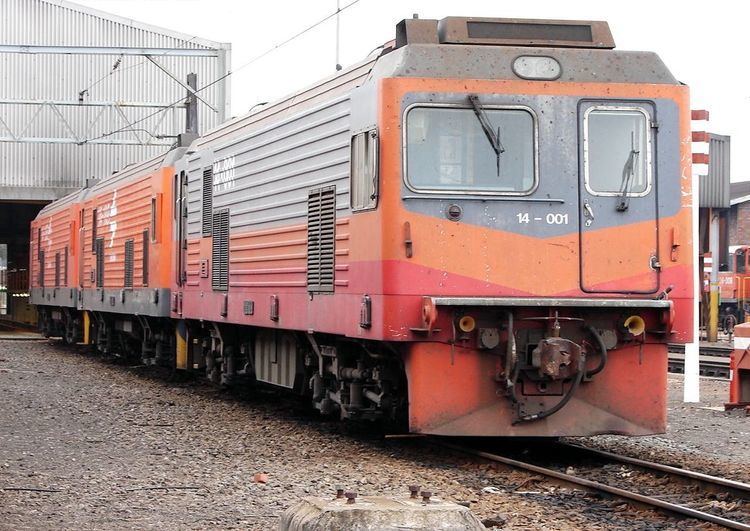Power type Electric Serial number 5415-5417 Build date 1988 | Designer 50 /s Group Model 50 /s Group 14E | |
 | ||
The Spoornet Class 14E of 1991 was a South African electric locomotive.
Contents
In 1990, Spoornet took delivery of three prototype Class 14E dual voltage electric mainline locomotives with a Bo-Bo wheel arrangement. They were the first dual voltage 3 kV DC and 25 kV AC locomotives to see service on South African rails when they were placed in service in 1991, and were followed in 1994 by ten locally manufactured Class 14E1 locomotives.
Manufacturer
In January 1984, the South African Railways (SAR) invited tenders for six prototype Class 14E locomotives. These were required to be dual voltage 3 kV DC and 25 kV AC locomotives, with self steering bogies and fully suspended AC traction motors, with a 3,800 kilowatts (5,100 horsepower) power output, plus some 400 kilowatts (540 horsepower) to be available for train services such as heating. The maximum speed was to be at least 160 kilometres per hour (99 miles per hour) with a 22,000 kilograms (49,000 pounds) maximum axle loading.
Only three prototype locomotives were eventually built and delivered in 1990. The 3 kV DC and 25 kV AC dual voltage Class 14E electric locomotive, the first dual voltage locomotive in South Africa, was designed by the 50 c/s Group consisting of SA Ateliers de Constructions Electriques de Charleroi (ACEC) of Belgium, AEG-Telefunken and Siemens of Germany, Alstom-Atlantique of France, and Brown Boveri of Switzerland. They were built by Swiss Locomotive and Machine Works (SLM) in Winterthur.
Characteristics
These dual cab locomotives have a roof access ladder on one side only, just to the right of the cab access door. The roof access ladder end is designated the no. 1 end. A corridor along the centre of the locomotive connects the cabs.
Unlike the later dual voltage Classes 19E, 20E and 21E, which were equipped to automatically transition between AC and DC mode on the run, the Class 14E had to be stopped and then restarted under the different voltage. Upon their introduction in 1990, these were some of the most powerful electric locomotives on the Spoornet roster. They featured three-phase AC motors (induction motors) made by Siemens. In addition, they incorporated Siemens' sophisticated train communication network system.
Amongst South African electric locomotives, the Class 14E was the first to have solid wheels with double helical or herringbone gears. All earlier South African electric locomotives, with the exception of the Orex Line's Class 9Es, ran on spoked wheels using spur gears. The locally built Class 14E1, on the other hand, ran on spoked wheels with helical gears.
Works numbers
On the Class 14E, the transformer serial numbers are engraved on a plate which depicts the circuit diagram of the transformer, mounted below the sill and halfway between the bogies on the roof access ladder side of the locomotive. These serial numbers do not follow the unit number sequence.
The respective SLM works numbers, transformer serial numbers, dates of delivery to Spoornet for testing and the dates placed in stock service are listed in the table.
Service
Class 14E locomotives are Bellville-based and are mainly employed in freight service on the route between Cape Town and Beaufort West in the Western Cape. Since they are dual voltage 3 kV DC and 25 kV AC locomotives, they can work on any electrified line country-wide, with the exception of the 50 kV AC Sishen – Saldanha iron ore line. On occasion, the Class 14E locomotives were employed to haul the Blue Train all the way along the Cape Town-Pretoria route across the 25 kV AC stretch between Beaufort West and Kimberley, but this task was usually performed by selected Class 14E1 locomotives. After two incidents, in 2013 with Class 14E1 no. 14-104 and in 2014 with Class 14E no. 14-001, when the locomotives caught alight and were destroyed while hauling the Blue Train, the Class was replaced by Class 18E locomotives on Blue Train service.
In 1998, a number of Spoornet's electric locomotives and most of their Class 38-000 electro-diesel locomotives were sold to Maquarie-GETX (General Electric Financing) and leased back to Spoornet for a ten-year period, which was to expire in 2008. Of the Class 14E, numbers 14-002 and 14-003 were included in this leasing deal.
Illustration
Class 14E locomotives were all painted in an orange, gray and red livery, unique to them. The Spoornet emblem on the sides with the name "SPOORNET" below the emblem, as displayed in the main picture, was only applied on no. 14-002, probably during repairs or a service, at the same time that its red lower sides were repainted to orange lower sides and dark gray sills. Only no. 14-001 survived long enough to receive the Blue Train livery in 2012.
